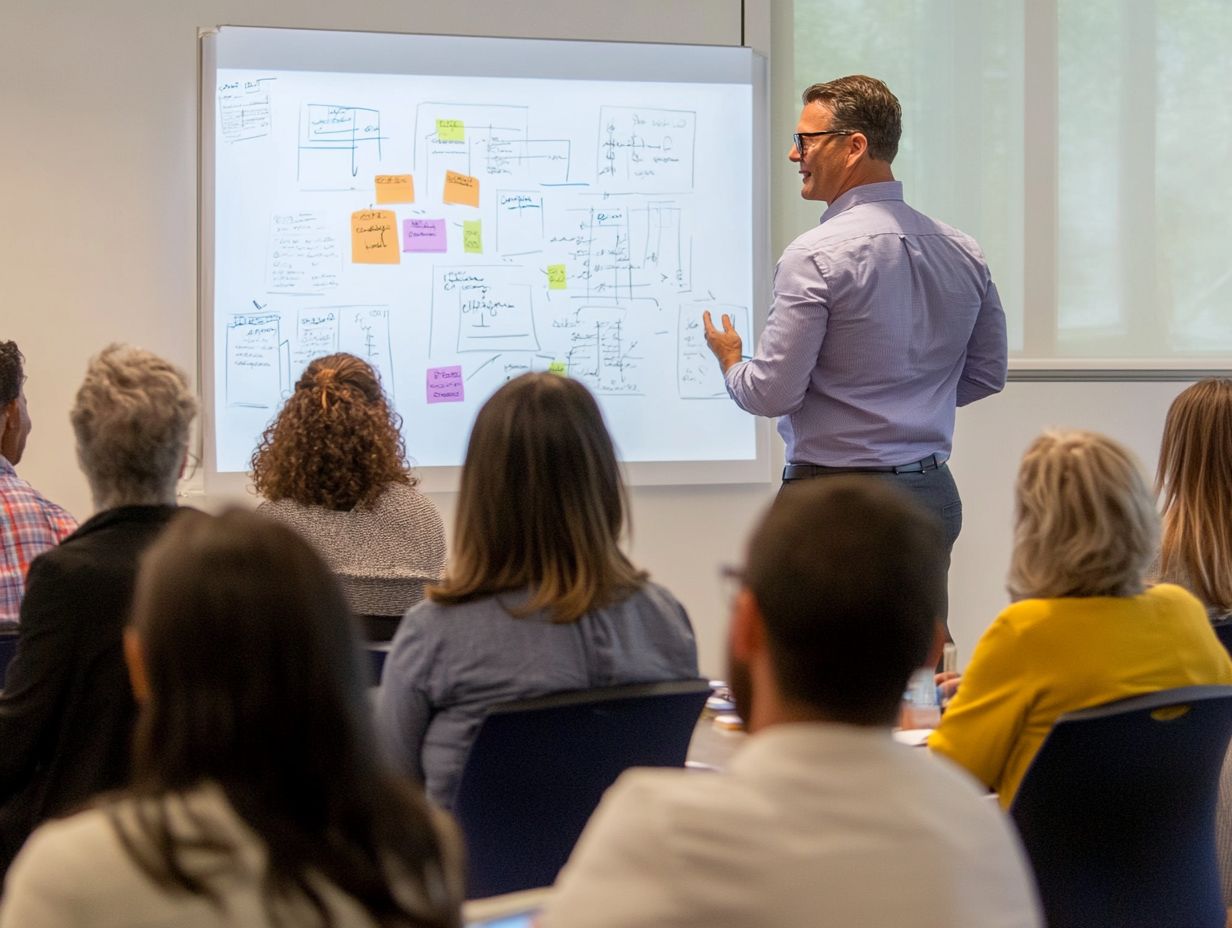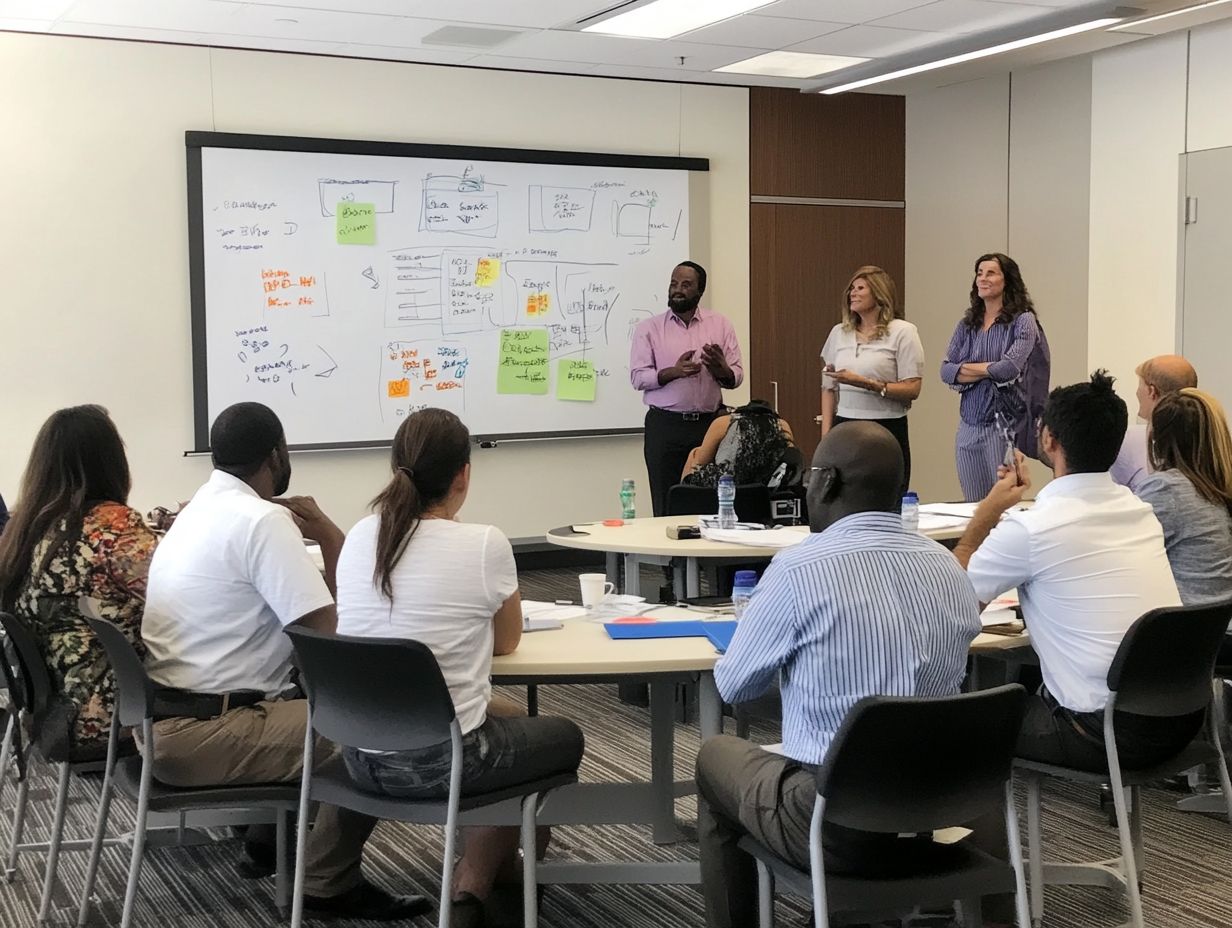5 Effective Leadership Development Models
In today s dynamic work environment, effective leadership has become more crucial than ever. This article delves into five transformative leadership models Situational, Transformational, Servant, Authentic, and Adaptive that challenge traditional approaches and provide fresh perspectives on guiding teams.
Each of these models offers unique principles and benefits, empowering you to create a more engaged and productive workplace. We ll also explore how to implement these models, the potential challenges they may present, and how your organization can select the right one to meet its specific needs.
Get ready to explore these exciting leadership frameworks! They have the potential to elevate your approach to guiding your team.
Contents
- Key Takeaways:
- 1. The Situational Leadership Model
- 2. The Transformational Leadership Model
- 3. The Servant Leadership Model
- 4. The Authentic Leadership Model
- 5. The Adaptive Leadership Model
- How Do These Models Differ from Traditional Leadership Models?
- What Are the Benefits of Using These Models for Leadership Development?
- What Are the Potential Challenges of Implementing These Models?
- How Can Organizations Choose the Right Model for Their Needs?
- Frequently Asked Questions
Key Takeaways:

- Each leadership development model offers unique approaches to effective leadership, including situational, transformational, servant, authentic, and adaptive models.
- These models differ from traditional leadership models by focusing on individualized, ethical, and adaptive leadership techniques.
- Organizations can implement these models in the workplace by providing training, mentorship, and creating a culture that promotes these leadership styles.
1. The Situational Leadership Model
The Situational Leadership Model is a dynamically adaptive framework. It emphasizes adapting your leadership style to meet the diverse requirements of your employees and the challenges presented by organizational culture.
This approach fosters effective leadership and enhances employee engagement in the workplace.
By acknowledging that not all employees are at the same stage of development, this model guides you in identifying the readiness levels of your teams. This insight empowers you to tailor your approach to align with each individual s skills and willingness to learn. For instance, when a team member is new and requires close supervision, a directive style may be most effective. On the other hand, when an employee demonstrates greater confidence and understanding, a delegating approach becomes more appropriate.
Through coaching and mentoring sessions, you can refine these adaptive skills, ensuring you navigate diverse workplace scenarios effectively and enable your team to achieve both personal and organizational goals.
2. The Transformational Leadership Model
The Transformational Leadership Model emphasizes that you, as a leader, have the power to inspire and motivate your employees to reach exceptional performance levels. By fostering a culture of trust, offering top-down support, and providing personalized development opportunities, you align individual growth with organizational success.
This approach invites you not only to share a compelling vision but also to actively listen to your team members. Active listening creates a dynamic environment where feedback is welcomed, valued, and acted upon.
Implementing regular communication channels allows you to profoundly impact employee engagement, making them feel appreciated and heard. You understand that every interaction shapes the workplace culture, which is why you prioritize transparency and collaboration.
Establishing effective feedback mechanisms ensures that your employees receive constructive insights that drive personal growth and enhance overall team performance, ultimately reinforcing their commitment to achieving shared goals.
3. The Servant Leadership Model
The Servant Leadership Model redefines your understanding of traditional leadership by placing the needs of your employees front and center. It emphasizes developing leadership competencies that cultivate a culture of accountability, continuous learning, and robust engagement within the workplace.
By actively listening and prioritizing the well-being of your team members, this approach fosters an environment where individuals feel genuinely valued and enabled. This not only enhances productivity but also encourages personal growth through effective coaching and mentoring initiatives.
For example, implementing mentoring programs can help you identify potential leaders among your employees. These programs provide tailored development plans that equip them with the skills and knowledge they need to thrive.
These roadmaps prepare the next generation of leaders and forge strong teams bound by trust and collaboration. This ultimately drives your organization toward lasting success.
4. The Authentic Leadership Model

The Authentic Leadership Model emphasizes the necessity for you to remain true to yourself and your values. By promoting effective communication skills and emotional intelligence, you can significantly enhance your interpersonal skills and overall leadership effectiveness within your organization.
As an authentic leader, you cultivate an environment where trust can thrive. This enables your team members to engage openly and share diverse perspectives.
By prioritizing self-awareness, you empower yourself to make more informed decisions. You will fully grasp how your actions resonate with your team. Integrity is the cornerstone of this model; as an authentic leader, you consistently align your behaviors with your values, fostering a culture of accountability.
You should implement comprehensive leadership assessments to identify individuals who embody these essential traits. These leaders inspire others through their genuine approach to leadership.
5. The Adaptive Leadership Model
The Adaptive Leadership Model enables you to tackle complex workplace challenges with strategic thinking and innovative leadership principles. It emphasizes the importance of continuous learning and responsiveness to ever-changing organizational dynamics.
In a world where technological advancements and market shifts occur at breakneck speed, your ability to adapt is more essential than ever. Take companies like Netflix; they embody adaptive leadership by consistently evolving their content strategies based on consumer feedback and viewing patterns.
By incorporating learning strategies such as A/B testing, you can make quick pivots to meet user demands and maintain a competitive edge. A/B testing involves comparing two versions of a webpage or product to see which one performs better.
Utilizing feedback mechanisms like employee surveys and customer input channels enables you to identify obstacles in real-time. This allows for swift implementation of solutions that enhance overall organizational resilience.
How Do These Models Differ from Traditional Leadership Models?
The transition from traditional leadership models to contemporary approaches such as situational leadership (a style where leaders change their approach based on what each team member needs), transformational leadership, and servant leadership underscores the importance of employee engagement and adaptive strategies in cultivating a vibrant workplace culture.
Modern leadership emphasizes collaboration and open communication. Unlike older models that leaned heavily on top-down directives, organizations adopting servant leadership create environments where employees feel valued and heard. This has a direct positive impact on morale and productivity.
Transformational leaders inspire their teams through shared visions and innovative ideas, fostering commitment and creativity. Companies that emphasize accountability cultivate an atmosphere where team members take ownership of their roles, enhancing overall performance.
Focusing on continuous learning supercharges your skills and equips your organization to swiftly adapt to industry changes, ensuring long-term success in an ever-evolving landscape.
What Are the Key Components of Each Model?
Each leadership model—situational, transformational, servant, authentic, and adaptive leadership—has distinct components that shape effective leadership and address skill gaps in training programs, including innovative approaches to leadership development.
These models champion a culture where team members feel valued and supported. For example, situational leadership encourages adapting styles to meet team members’ unique needs, while transformational leadership ignites motivation through compelling shared visions. Additionally, exploring leadership development tools can further enhance these approaches.
Servant leadership prioritizes the growth and well-being of your team, showcasing a strong commitment to nurturing talent. Authentic leadership builds trust and genuine connections among colleagues, while adaptive leadership promotes resilience by urging teams to embrace change.
Incorporating these elements into your training offerings enhances participant experiences, enabling future leaders to foster environments prioritizing ongoing development and collaborative success.
How Can These Models Be Implemented in the Workplace?

Implementing leadership models in the workplace requires a strategic approach with tailored training, coaching, and interactive learning experiences that cater to employees’ unique needs, as outlined in 5 ways to measure leadership development success.
Start by assessing your current leadership frameworks and identifying skill gaps. Incorporating coaching sessions cultivates a culture of continuous improvement, allowing leaders to hone their skills through feedback and evaluations.
Mentoring programs connect seasoned leaders with emerging talent, facilitating knowledge transfer and fostering growth. By integrating training modules into remote learning platforms, you offer flexible access to resources, accommodating diverse learning styles.
This multifaceted approach elevates leadership effectiveness and strengthens team dynamics, driving your organization toward success.
Are you ready to transform your leadership style today?
What Are the Benefits of Using These Models for Leadership Development?
Utilizing modern ways of leading people for your leadership development can yield remarkable benefits. These include enhanced employee performance, greater organizational success, and effective learning strategies that align with the ever-evolving needs of the workplace.
When you embrace these models, you’re likely to witness improved employee retention rates. Team members feel more engaged and valued. Implementing strategies for developing future leaders promotes open communication, cultivating a culture of trust and collaboration.
You ll notice measurable results, such as increased productivity. Employees are motivated to excel in their roles, driven by a clear sense of purpose and direction. Leaders who master these models often foster a greater sense of accountability within their teams. This results in not just individual growth, but also collective achievements that significantly bolster organizational effectiveness.
What Are the Potential Challenges of Implementing These Models?
While embracing modern leadership models can bring about transformative benefits, you might face some challenges. These include resistance to change, difficulties in reshaping workplace culture, and the need for ongoing support to fully unlock the potential of these models.
These obstacles often arise from entrenched practices and employees’ trepidation regarding evolving roles or expectations. To effectively navigate these challenges, prioritize transparent communication and actively involve your team in the transition process. This approach fosters a sense of ownership and encourages collaboration among all members.
Investing in comprehensive training programs equips your employees with the skills and mindset required to embrace new methodologies. Establishing robust feedback mechanisms enables you to address concerns proactively and refine strategies. Ultimately, this nurtures an adaptive and resilient organizational culture that is open to continuous improvement.
How Can Organizations Choose the Right Model for Their Needs?
Choosing the right leadership model for your organization demands a comprehensive evaluation of its unique needs, culture, and objectives. This alignment is vital for corporate strategy and the sustained engagement of your employees.
This process requires you to deeply understand the existing organizational culture. Leaders fundamentally shape workplace dynamics. It s essential to consider how your chosen model meets employee needs, as effective leadership has a direct influence on motivation, productivity, and overall satisfaction.
Incorporating leadership assessments is crucial for gauging the strengths and weaknesses of potential leaders. These assessments offer invaluable insights, ensuring that your selected leadership approach resonates with the workforce and aligns with long-term business goals. Ultimately, this fosters a resilient and adaptive environment where both the organization and its people can thrive.
Frequently Asked Questions

What are the top 5 effective leadership development models?
- Situational Leadership
- Servant Leadership
- Transformational Leadership
- Authentic Leadership
- Adaptive Leadership
What is Situational Leadership?
Situational Leadership is a model that suggests leaders should adapt their leadership style based on the readiness, or competence and commitment, of their followers.
What is Servant Leadership?
Servant Leadership is a model that prioritizes the needs and development of followers over the leader’s own interests. It focuses on serving others to ultimately achieve success.
What is Transformational Leadership?
Transformational Leadership inspires and motivates followers to achieve a common goal by creating a vision and empowering them to reach their full potential.
What is Authentic Leadership?
Authentic Leadership emphasizes self-awareness, transparency, and ethical behavior to build trust and credibility with followers.
What is Adaptive Leadership?
Adaptive Leadership focuses on the ability to adapt and lead in complex and rapidly changing situations, with a focus on learning and innovation.
Don’t wait act now to enhance your leadership skills!






